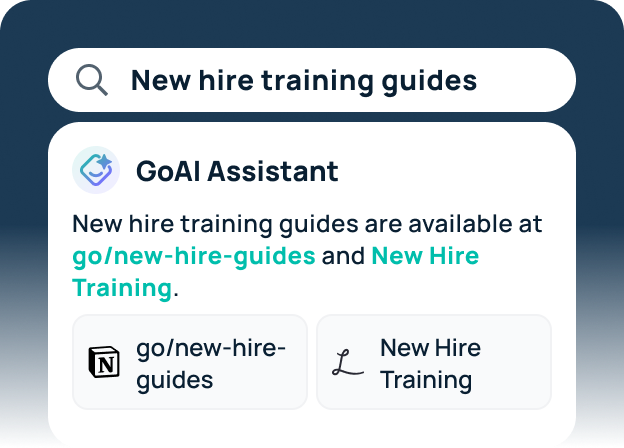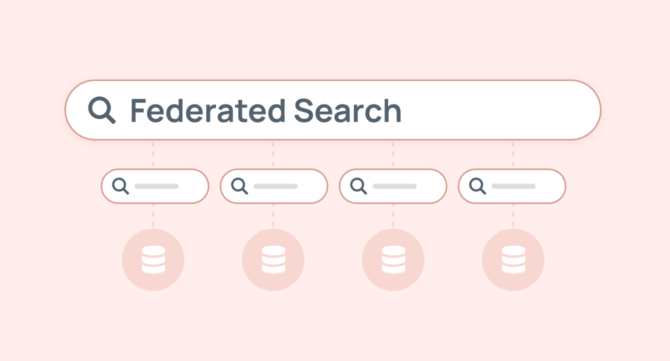What do the United States, FIFA, and multi-system search have in common? They’re all federated systems.
Put simply, “federated” (adj.) refers to a single centralized unit with subdivisions that retain some internal autonomy. In the United States, those subdivisions are independent states under the federal government. In the world of football (the one without helmets), over 200 national associations make up the international governing body FIFA.
We’re here to talk about the last example: multi-system search, or federated search for internal knowledge discovery. In this article, we’ll share some key facts and helpful tips about this type of search engine. Here’s what we’ll cover:
- Fact 1: Purpose of federated search solutions
- Fact 2: Define federated search
- Fact 3: How federated querying works
- Fact 4: Pros and cons
- Tip 1: Federated vs. unified enterprise search
- Tip 2: Find the right search solution for your business
Fact 1: Purpose of federated search solutions
Large companies use internal search methods like federated search to simplify knowledge discovery and resource access. Today, GenAI features like machine learning and natural language processing help intelligent search platforms analyze semantic context, decipher query intent, and return contextually relevant results and insights.
SaaS companies building intelligent search solutions are creating two main types: federated or unified enterprise search (see Tip 1 below).
Fact 2: Definition of federated search
What is federated search?
Federated search is the process of searching multiple data sources independently and presenting combined results to the user. As the centralized interface in a federated system, the search platform runs separate searches on its subdivisions, or individual data repositories – which have their own rules and indexes.

What is it NOT?
We want to clarify: the main types of federated search that some people refer to – search time merging and index time merging – are entirely different. The first is federated, the other isn’t.
That’s because federated search does not rely on a central index. We’ll explain how it works below, and we’ll cover another type of search – unified enterprise search – that uses index time merging.
Fact 3: How federated querying works
Federated querying allows you to type a single query into the search platform, which returns results that it retrieved from various data sources – such as internal intranets and apps, external databases, or your company’s Google cloud data.
The federated search tool doesn’t crawl, index, or store data. Instead, it runs live search queries on different data sources every time the user wants to search something. These real-time queries rely on indexes and data stored in third-party systems – meaning more factors affect the quality of results.
Fact 4: Pros and cons of federated search
If you’re considering a federated search vendor as part of your enterprise knowledge management system, you should weigh the following pros and cons:
Pros:
- Simple setup: because federated search tools don’t crawl and index data, they require little effort and minimal time to set up.
- AI enhancements: by leveraging LLMs, developers are expanding the functionalities. They’re also incorporating RAG (Retrieval Augmented Generation) to improve result quality and accuracy.
- User-friendly interface: the federated search platform creates a connection between users and company data that does not require any knowledge of Cloud SQL, Google SQL query, or data analysis.
Cons:
- Slow response time: the need to run individual queries across multiple systems creates high latency, or slow response times.
- Search constraints: federated search relies on each data source’s search API and internal index, which can constrain users’ search syntax, limit filter use, and complicate security and access permissions.
- Knowledge gaps: if a data source doesn’t have its own index or querying capabilities, it is effectively unsearchable. This creates gaps in users’ access to data.
- Risk of hallucinations: when intelligent search tools rely too heavily on LLMs, they increase the risk of AI hallucinations in search results. These inaccurate results misdirect users and undermine trust in the search platform.

Tip 1: Compare federated vs. unified enterprise search
If you want a workplace search solution ASAP and don’t mind limited functionality, federated search could work for you. But there’s an alternative that could better meet your needs: unified enterprise search. We’ll cover potential pros and cons here, or you can check out this article on enterprise search as a service for a thorough overview and definition.
Pros:
- Fast results: enterprise search maintains a central index that speeds up information retrieval across all connected sources. This means it’s faster than federated search.
- Fine-tuned searching: with one unified search across a single index, enterprise search allows greater control over query parameters – like filters, facets, relevance rankings, and natural language processing.
- Zero knowledge gaps: enterprise search crawls all data sources, including those lacking their own internal search tools. This powers comprehensive data access.
Cons:
- Long setup time: enterprise search can require higher implementation effort than federated search. It must connect to and crawl data sources to build the central index.
- Index relevance: the central index needs to constantly update to provide relevant answers. If it doesn’t update frequently enough, users could miss out on new information.
- Privacy concerns: the central index could introduce privacy concerns, some argue, since it houses all connected company data and could be vulnerable to data breaches.
Tip 2: Find the right search solution for your business
We’ve done the research and recommend unified enterprise search for the fastest, most comprehensive workplace search. Plus, the best enterprise search software gives you all the pros without compromising on the cons above.

That’s what GoSearch offers. Here’s how this unified enterprise search tool gives you secure, AI-powered knowledge access:
⚡ Fast results from connected company sources
🤖 Generative AI chatbot and semantic search
💯 Relevant results backed by AI vector search
🚀 Easy implementation for company-wide launch within 2 hours
🔁 Index updates in real-time to capture new data
🔒 Highest-standard security, data protection, and index controls
Federated search FAQs
How does federated search handle security and access permissions across multiple data sources?
Federated search handles security and access permissions across multiple data sources by relying on each data source’s individual security measures. Access control mechanisms, such as authentication and authorization, are typically managed within each data repository. Federated search platforms must integrate with these existing security frameworks to ensure that users only have access to the data they are authorized to view.
How do federated search solutions handle scalability as a company’s data sources grow or change?
Federated search solutions handle scalability by providing flexibility in accessing and querying diverse data sources. As a company’s data sources grow or change, federated search platforms can adapt by integrating new sources or updating existing connectors. Additionally, advancements in federated search technology, such as improved query optimization and distributed computing, help ensure efficient performance and scalability as the volume of data increases.
Are there any industry-specific considerations or challenges when implementing federated search solutions?
Industry-specific considerations may include compliance requirements, data privacy regulations, and domain-specific search capabilities. For example, financial institutions may need to ensure that federated search complies with regulations such as GDPR or SEC rules governing data protection and privacy. Likewise, organizations in highly regulated industries like healthcare or government may require specialized search functionalities tailored to their specific data types and access control policies.
What strategies or best practices can companies follow to minimize the risk of hallucinations or inaccurate search results when using federated search?
To minimize the risk of hallucinations or inaccurate search results in federated search, organizations can implement several best practices. These may include rigorous testing and validation of search algorithms, leveraging domain-specific knowledge graphs or ontologies to improve result relevance, and implementing human-in-the-loop validation mechanisms to verify the accuracy of AI-generated insights. Additionally, ongoing monitoring and feedback loops can help identify and address any issues with search result quality or relevance, ensuring that users can trust the federated search platform to deliver accurate and reliable information.
Access your unified company sources with GoSearch
Ready to boost resource discovery and streamline workflows? Book a demo today to learn how you can unlock company knowledge with a single search.
Search across all your apps for instant AI answers with GoSearch
Schedule a demo

















